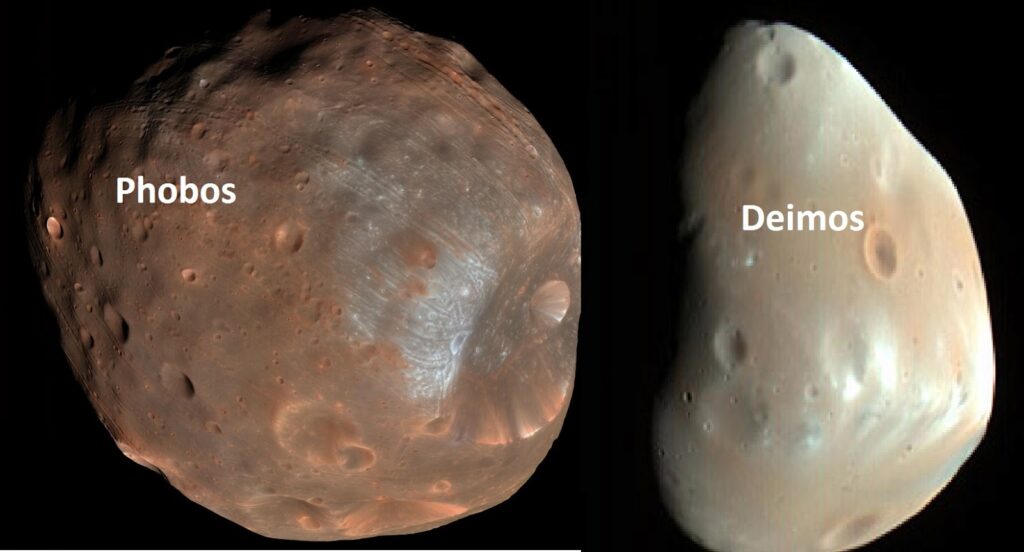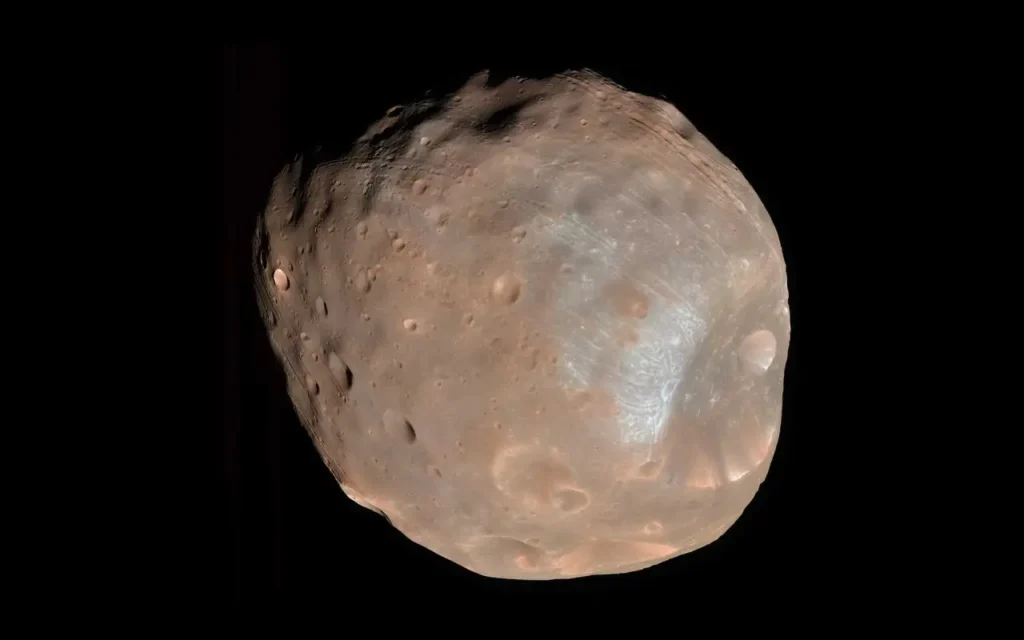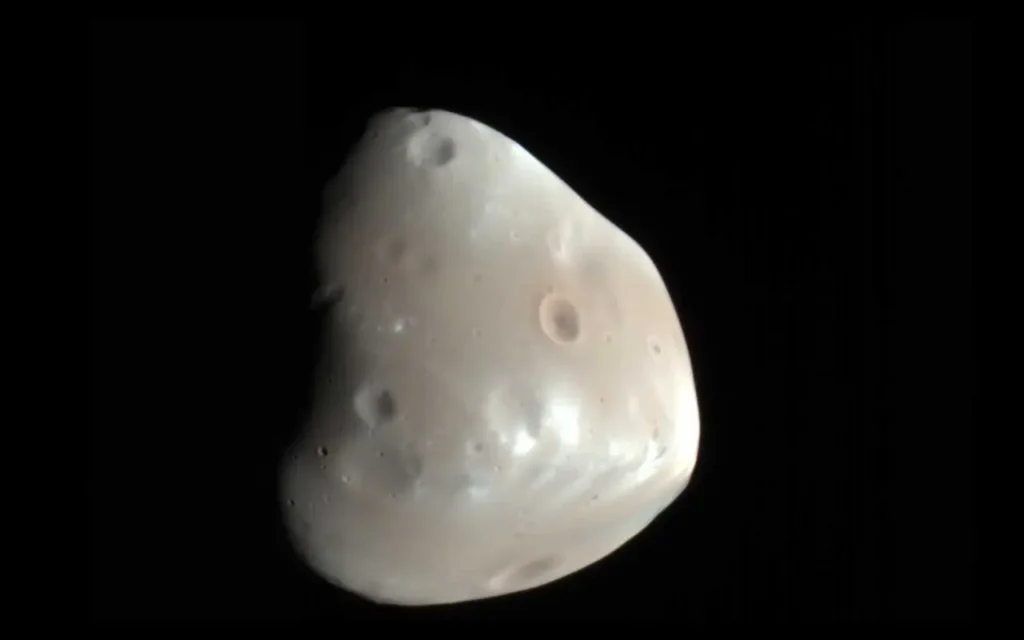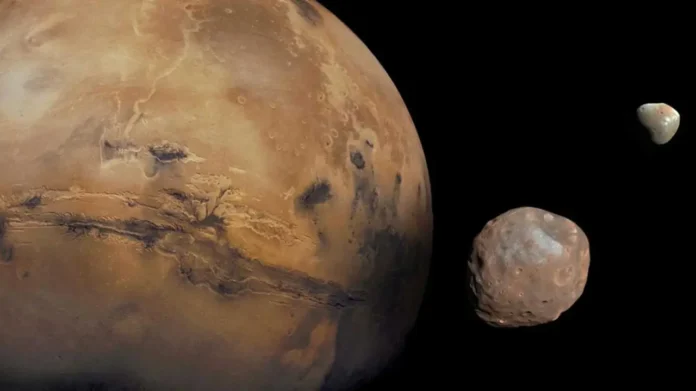Mars, the Red Planet, has long fascinated humanity with its barren landscapes, towering volcanoes, and vast canyons. As the fourth planet from the Sun, Mars is a significant part of our solar system, and its study has provided valuable insights into the formation and evolution of our cosmic neighborhood. We often overlook Mars’ moons, but they play a crucial role in the planet’s story.
Phobos and Deimos, the two natural satellites of Mars, are small but intriguing worlds that offer a unique window into the planet’s history and the potential for future exploration. In this blog post, we will delve into some fascinating facts about Mars’ moons, exploring their discovery, characteristics, origins, and potential for future exploration. From their irregular shapes and heavily cratered surfaces to their orbital patterns and composition, we will uncover the secrets of these mysterious worlds.
Key Facts
- Size: Phobos is about 22.2 km (13.8 mi) in diameter, while Deimos is about 12.6 km (7.8 mi) in diameter.
- Orbital Period: Phobos orbits Mars in about 7.66 hours, while Deimos takes about 30.35 hours.
- Distance from Mars: Phobos orbits at about 6,000 km (3,728 mi), while Deimos orbits at about 20,000 km (12,427 mi).
- Theories on Origin: Captured asteroids, debris from early solar system formation, or formed from a debris disk around Mars.
- Composition: Primarily rock and ice, similar to C-type asteroids.
- Largest Crater on Phobos: Stickney, measuring about 9 km (5.6 mi) in diameter.
- Past Missions: Mariner 9, Mars Global Surveyor, and Mars Reconnaissance Orbiter have studied Phobos and Deimos.
- Future Plans: NASA’s ExoMars mission and Mars Sample Return mission may include studies of Phobos and Deimos.
- Potential for Human Exploration: Phobos and Deimos offer potential opportunities for human exploration and habitation.
Discovery of Phobos and Deimos

American astronomer Asaph Hall discovered Mars’ moons, Phobos and Deimos, on August 18, 1877. Hall was working at the United States Naval Observatory in Washington, D.C. at the time, and he was tasked with searching for a hypothetical second moon of Mars. After months of intense searching, Hall finally spotted the two moons, which were initially thought to be asteroids orbiting the planet.
Origin of Mars Moons
The origin of Mars’ moons, Phobos and Deimos, has been a topic of debate among scientists for decades. The most widely accepted theory is that Phobos and Deimos are captured asteroids or debris from the early formation of the solar system. This theory is supported by the moons’ small size, irregular shapes, and heavily cratered surfaces, which are characteristics that asteroids commonly exhibit.
However, some scientists argue that the near-circular orbits of Phobos and Deimos make it unlikely that they are captured asteroids. Alternative theories suggest that the moons may have formed from a debris disk around Mars or from the impact that created the Borealis basin on Mars’ northern hemisphere.
Size and Shape of Phobos and Deimos
Phobos and Deimos are significantly smaller than Earth’s Moon, both in terms of size and mass. Phobos, the larger of the two moons, has an average diameter of approximately 14 miles (22 kilometers), while Deimos measures around 8 miles (12 kilometers) in diameter. To put their size into perspective, Earth’s Moon has a diameter of about 2,159 miles (3,475 kilometers). In terms of shape, Phobos has an irregular shape resembling a misshapen potato, with its longest axis spanning about 17 miles (27 kilometers). Deimos, on the other hand, has a more spherical shape, akin to a heavily cratered miniature version of our Moon.
Orbits and Tidal Effects
Phobos orbits Mars at a distance of about 6,000 kilometers (3,728 miles), which is closer than any other moon in the solar system. It completes one orbit around Mars in just 7 hours and 39 minutes, which is faster than Mars’ rotation period. Deimos, on the other hand, orbits Mars at a distance of about 20,000 kilometers (12,427 miles) and takes about 30 hours to complete one orbit.
Interestingly, the gravitational forces exerted by Mars on these moons create significant tidal effects. The tidal forces acting on Phobos have led to its orbit gradually decaying, such that it is progressively spiraling closer to Mars. Scientists predict that in about 30 to 50 million years, Phobos will collide with Mars or tidal forces will tear it apart, resulting in the formation of a ring system around the red planet. Deimos, however, is beyond the reach of Martian tidal forces and will continue its leisurely orbit for countless millennia.
Surface Features of Phobos and Deimos

Countless cosmic interactions have shaped the surfaces of Phobos and Deimos, adorning them with intriguing features. Impact craters heavily pockmark Phobos, with the largest one named Stickney Crater after the wife of American astronomer Asaph Hall, who discovered the moon. The Stickney crater stretches approximately 6 miles (10 kilometers) in diameter, occupying a significant portion of Phobos’ surface. Grooves, known as “grooves of Phobos,” crisscross the moon’s terrain, adding to its peculiar appearance. Scientists believe that intense stress caused by tidal forces exerted by Mars is responsible for these grooves.
Deimos, on the other hand, exhibits a smoother surface with fewer craters. Fine dust and small boulders compose the moon’s regolith, which is the layer of loose, fragmented material on the surface. The absence of substantial craters on Deimos suggests either infrequent impacts or the refreshing or alteration of its regolith over time. Both moons cover with a layer of fine dust, which often gives them a reddish hue, consistent with the notorious rust-colored landscape of Mars.
Composition and Internal Structure
Extensive studies and investigations have shed light on the composition and internal structure of Phobos and Deimos. Spectroscopic analyses of their surfaces indicate that both moons share a composition largely consistent with that of carbonaceous chondrite meteorites, similar to asteroids found within our solar system. Scientists believe that these meteorites are remnants from the early days of our solar system.
The internal structure of Phobos and Deimos remains less clear, but scientists propose that both moons likely consist of a mixture of rock and ice, with the ice content increasing towards the interior. This composition aligns with the captured asteroid theory, as it suggests that the moons may have originated from asteroids rich in volatile materials such as water ice.
Scientists believe that the subsurface of Phobos harbors a collection of loose rubble, known as a “rubble pile”. Scientists believe that Mars’ tidal forces breaking apart the moon’s interior over time created this loose configuration. Deimos, on the other hand, may possess a more solid structure due to its larger distance from Mars and weaker tidal effects.
Missions to Study the Moons
Various space missions have been conducted to study Phobos and Deimos, unraveling their mysteries and shedding light on the intriguing world of Martian moons. One of the most notable missions was the Mars Global Surveyor, launched by NASA in 1996. This mission, equipped with sophisticated instruments and cameras, provided invaluable data about the surface composition, topography, and gravitational field of Phobos and Deimos. The Mars Express mission, led by the European Space Agency (ESA), launched in 2003 and conducted detailed investigations of the moons’ surfaces, composition, and interior structures. These missions have greatly expanded our knowledge of the Martian moons and paved the way for future explorations.
Habitable Potential of the Moons
While habitability on the Martian moons remains speculative, some studies have explored the potential for sustaining life or supporting future human activities. The availability of water and the presence of organic compounds on Phobos and Deimos, as evidenced by spectroscopic analyses, raise intriguing possibilities for resource utilization. These celestial bodies could potentially serve as stepping stones for further space exploration and colonization.
The carbonaceous chondrite composition of Phobos and Deimos suggests the presence of a significant amount of water ice locked beneath their surfaces. This frozen water could be extracted and processed to provide water for life support systems and the production of rocket propellant, thus reducing the need for expensive Earth-based resupply missions during future space exploration endeavors.
Additionally, the regolith present on the moons could contain valuable resources such as metals and other minerals, presenting opportunities for in-situ resource utilization. Extracting and utilizing these resources could potentially extend human presence and activities in the Martian system.
Comparison to Other Moons in the Solar System

As we explore the Martian moons, it is intriguing to compare them with other moons within our solar system. Phobos and Deimos are quite distinct from the grandeur and complexity of large moons such as our own Moon or Jupiter’s Ganymede. Their irregular shape, small size, and relatively simple geology set them apart. However, the similarities between the Martian moons and certain distant asteroids are striking. This resemblance has fueled the belief that Phobos and Deimos were likely captured asteroids, forever bound to orbit the red planet.
The Mars moons’ composition and structure also draw comparisons to the icy moons of the outer solar system, such as Jupiter’s Europa and Saturn’s Enceladus. These icy moons, believed to harbor subsurface oceans, have sparked immense interest as potential sites for extraterrestrial life. While Phobos and Deimos are not expected to host such subsurface oceans, they provide valuable insights into the dynamics and origin of smaller celestial bodies within our solar system.
Volcanic Activities on Mars Moons
The question of whether Phobos and Deimos exhibit volcanic activities has been a topic of scientific interest. However, based on available data and observations, there is currently no definitive evidence to suggest active volcanism on these Martian moons.
Phobos, with its heavily pockmarked surface, displays numerous impact craters but lacks the characteristic volcanic features, such as lava flows or volcanic cones, seen on other volcanic bodies within our solar system.
Deimos, with its smoother surface and relatively fewer impact craters, does not exhibit any apparent volcanic structures either. This suggests that neither moon has experienced recent volcanic activities that reshape their surfaces.
Size Comparison: Phobos and Deimos vs. Earth’s Moon
When comparing the size of Phobos and Deimos to Earth’s Moon, it becomes evident how much smaller and more petite the Martian moons are. Phobos, the larger of the two, has an average diameter of approximately 14 miles (22 kilometers), while Deimos measures around 8 miles (12 kilometers) in diameter. To put their size into perspective, Earth’s Moon boasts an average diameter of about 2,159 miles (3,475 kilometers).
Relative to the Moon, both Phobos and Deimos are tiny celestial companions, resembling captured asteroids more than proper moons. While the Moon has played a significant role in shaping Earth’s history, influencing tides and providing a stable natural satellite, the Martian moons exist on a much smaller scale, orbiting the red planet as cosmic reminders of an ancient era.
The Mystery of Phobos’ Fate: Will it Crash into Mars?
Phobos, the larger of the Martian moons, has captivated scientists with its future fate. Due to Martian tidal forces, Phobos is gradually spiraling closer to Mars, a phenomenon known as orbital decay. The rate of this decay suggests that Phobos will ultimately meet its destiny within the next few dozen million years.
Two potential outcomes await Phobos. In the first scenario, as Phobos gets closer to Mars, tidal forces will eventually overcome its structural integrity, causing it to disintegrate and form a vast ring system around the red planet. Similar to Saturn’s majestic rings, Mars may one day bear witness to the splendor of a ring-draped sky.
The second and more dramatic outcome involves a collision between Phobos and Mars. As Phobos continues its descent toward its parent planet, it will eventually cross the Roche limit, the threshold at which tidal forces overcome gravitational forces, effectively tearing the moon apart. The resulting debris would form a temporary ring around Mars before eventually coalescing into a disk of matter that could give rise to smaller moons or reaccumulate into a single new moon.
The ultimate fate of Phobos remains uncertain, but its story is intimately entwined with the destiny of Mars itself. Both the collision and ring formation scenarios offer exciting prospects for scientific investigation and the study of planetary dynamics.
Human Exploration of Mars Moons: A Possibility?
The possibility of human exploration of Mars’ moons, Phobos and Deimos, has been considered by scientists and space agencies. While there are several challenges to overcome, the potential benefits of such an endeavor are significant. Here are some key points to consider:
Challenges
- Distance and Gravity: Phobos and Deimos are much closer to Mars than the Moon, which means that the gravitational pull on a spacecraft would be much weaker. This would require specialized propulsion systems and landing techniques.
- Radiation and Temperature: The Martian moons are exposed to intense radiation and extreme temperatures, which could pose significant risks to both the spacecraft and the human crew.
- Atmosphere and Pressure: The moons have no atmosphere, which means that there is no air resistance or pressure to speak of. This would require specialized suits and equipment for human exploration.
Potential Benefits
- Scientific Discovery: Human exploration of the Martian moons could provide valuable insights into the formation and evolution of the Martian system.
- Resource Utilization: The moons could potentially be used as a source of resources, such as water and minerals, which could be used to support human missions to Mars.
- Stepping Stone for Mars: The Martian moons could serve as a stepping stone for human missions to Mars, providing a testing ground for technologies and strategies that could be used on the Martian surface.
Conclusion
In this blog post, we have explored the fascinating world of Mars’ moons, Phobos and Deimos. From their discovery and characteristics to their origins and composition, we have delved into the many intriguing aspects of these small but significant worlds.Phobos and Deimos are more than just small, irregularly shaped moons orbiting Mars. They offer a unique window into the history and potential for future exploration of the Martian system. As we continue to study these mysterious worlds, we may uncover new insights into the formation and evolution of our solar system.
Frequently asked question
What are the names of Mars’ two moons?
Mars’ two moons are called Phobos and Deimos.
What is the composition of Phobos and Deimos?
The composition of Phobos and Deimos is still a mystery, but they are believed to be made up of a mixture of rock and ice.
What are some unique features of Phobos and Deimos?
Phobos and Deimos have some unique features, such as their irregular shapes and low density. They also have various impact craters on their surfaces.
How did Phobos and Deimos form?
There are several theories about the formation of Phobos and Deimos. One theory suggests that they are captured asteroids, while another proposes that they formed from debris ejected during a large impact on Mars.
Have there been any spacecraft explorations of Phobos and Deimos?
Yes, several spacecraft missions have explored Phobos and Deimos, including NASA’s Mars rovers and the European Space Agency’s ExoMars mission.
Are there any potential future missions planned to study Phobos and Deimos?
Yes, there are potential future missions being considered to further study Phobos and Deimos and unveil more of their secrets.
How do the Martian moons impact Mars?
The gravitational influence of Phobos and Deimos on Mars can potentially affect its rotation and tides. They also play a role in the Martian system’s overall dynamics.
What is the future role of Mars’ moons in colonization?
Mars’ moons could play a significant role in future colonization efforts. They could serve as potential bases for human habitation, providing resources and a strategic location for further exploration of Mars.
